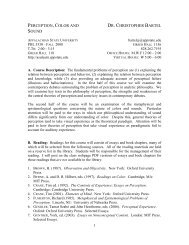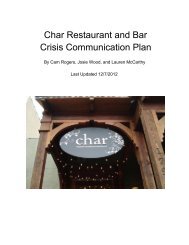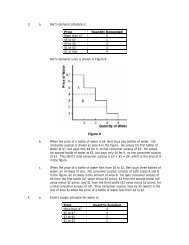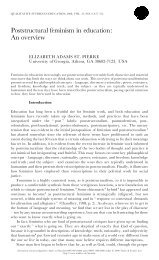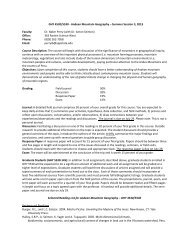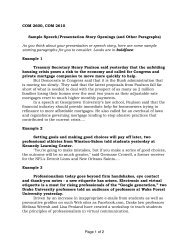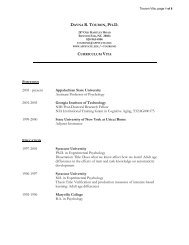Plate Tectonics: The Grand Unifying Theory of Geology
Plate Tectonics: The Grand Unifying Theory of Geology
Plate Tectonics: The Grand Unifying Theory of Geology
Create successful ePaper yourself
Turn your PDF publications into a flip-book with our unique Google optimized e-Paper software.
<strong>Plate</strong> <strong>Tectonics</strong><br />
<strong>The</strong> <strong>Grand</strong> <strong>Unifying</strong> <strong>The</strong>ory <strong>of</strong> <strong>Geology</strong><br />
Earth’s lithosphere is divided into a<br />
number <strong>of</strong> pieces, called plates<br />
<strong>The</strong>se plates <strong>of</strong> rigid lithosphere ride<br />
over the s<strong>of</strong>ter, ductile asthenosphere<br />
Motion <strong>of</strong> these plates cause nearly all<br />
geologic features we observe on the<br />
earth’s surface
<strong>Plate</strong> <strong>Tectonics</strong><br />
• <strong>Plate</strong> tectonic theory is powerful.<br />
• It provides a unified mechanism explaining:<br />
– Igneous, sedimentary, and metamorphic rocks.<br />
– <strong>The</strong> distribution <strong>of</strong> earthquakes and volcanoes.<br />
– <strong>The</strong> origin <strong>of</strong> continents and ocean basins.<br />
– <strong>The</strong> distribution <strong>of</strong> fossil plants and animals.<br />
– <strong>The</strong> genesis and destruction <strong>of</strong> mountain chains.<br />
– Continental drift.
Elevations and Lithospheric Loading<br />
• <strong>The</strong> weight <strong>of</strong> the lithosphere causes depression <strong>of</strong><br />
the asthenosphere and bending in the lithosphere
Buoyancy<br />
• First described by Archimedes more than 2.2 ka.<br />
• Floating solids displace water equal to their mass.<br />
• An iceberg “sinks” until the mass <strong>of</strong> water it displaces<br />
is equal to the total mass <strong>of</strong> the iceberg.<br />
• This concept applies to lithospheric plates.<br />
– Continental – Floats higher.<br />
– Oceanic – Sinks lower.
Why Are Continents Higher?<br />
• Continental Crust - granite – density ~2.6 g/cm 3<br />
• Oceanic Crust – basalt – density ~3.0 g/cm 3<br />
:: Review Hypsograph Exercise ::
<strong>The</strong> Major <strong>Plate</strong>s <strong>of</strong> Earth’s Lithosphere<br />
- Most plates contain both oceanic and continental crust.<br />
A few contain only oceanic crust. Thus a plate ≠ a continent<br />
- Not all boundaries between continents and oceans are plate<br />
boundaries
<strong>Plate</strong> boundaries are zones <strong>of</strong> many earthquakes<br />
- Earthquakes clearly outline major plate boundaries.<br />
- Thus active continental margins ARE plate margins.<br />
Passive continental margins are NOT plate margins.<br />
- So what happens at passive margins?
Active & Passive Margins<br />
• Margin: boundary<br />
between a continent and an<br />
ocean<br />
• Active Margin: A<br />
continental shoreline that<br />
IS a plate boundary<br />
• Passive Margin: A<br />
continental shoreline that<br />
IS NOT a plate boundary<br />
• Continental Shelf: Thick<br />
sediment cover, gentle<br />
slope, shallow to moderate<br />
depth<br />
• Abyssal Plain: nearly flat<br />
in slope, deep depth,<br />
overlies oceanic crust<br />
Cross-section <strong>of</strong> a typical passive margin
<strong>The</strong> Major <strong>Plate</strong>s <strong>of</strong> Earth’s Lithosphere<br />
- Geologists define only three types <strong>of</strong> plate boundaries<br />
1- Divergent<br />
2- Convergent<br />
3- Transform
Type 1 - Divergent <strong>Plate</strong> Boundary<br />
• Divergent - Two plates<br />
that pull away or separate<br />
from each other.<br />
• Produce new crust<br />
• Examples: Mid Atlantic<br />
Ridge, East Pacific Rise<br />
• Effect <strong>of</strong> movement – Sea<br />
Floor Spreading<br />
:: Divergent Animation ::
Type 2 - Convergent <strong>Plate</strong> Boundary<br />
• Convergent - Two plates<br />
that move towards or<br />
collide with each other.<br />
• Consume old crust<br />
• Example, India into Asia,<br />
NW Coast <strong>of</strong> U.S. SW<br />
coast <strong>of</strong> South America<br />
• Effect <strong>of</strong> movement –<br />
Subduction or Collision<br />
:: Convergent Animation ::
Type 3 - Transform <strong>Plate</strong> Boundary<br />
• Transform - Two plates that<br />
slide horizontally past each<br />
other.<br />
• Do NOT consume or create<br />
crust<br />
• Example, North Anatolian<br />
Fault (Turkey), Dead Sea<br />
Fault (Israel, Jordan), San<br />
Andreas Fault<br />
• Effect <strong>of</strong> movement –<br />
Transform Faulting<br />
:: Transform Animation ::
Divergent Boundaries<br />
• Sea-floor spreading causes plates to move apart.<br />
• Magma wells up to fill the gap.<br />
• Magma cools, adding material to each plate.
Divergent <strong>Plate</strong> Boundaries: Sea Floor Spreading
New Oceanic Crust at Mid-Ocean Ridges Intrudes from Dikes<br />
Dike: A steep (~vertical) cracks filled with magma
Mid-Ocean Ridges<br />
• Linear mountain ranges in Earth’s ocean basins.<br />
• Example: <strong>The</strong> Mid-Atlantic Ridge<br />
– Snakes N-S through the entire Atlantic Ocean.<br />
– Elevated ridge 1,500 km wide and 2 km above abyssal plains.
Why Are Mid-Ocean Ridges Elevated?<br />
Mid-ocean ridges are high above most <strong>of</strong> the seafloor<br />
This is because new oceanic crust is warmer and less<br />
dense, and very little lithosphere has been added,<br />
close to the ridges.<br />
Further from the ridges, the crust is cool and more<br />
dense, and the thicker lithosphere adds even more<br />
weight, pulling the whole lithosphere down into the<br />
asthenosphere
Mid-Ocean Ridge Activity:<br />
Black Smokers & Pillow Basalts<br />
• Magma heats water and it jets out <strong>of</strong> these<br />
chimney-like vents. <strong>The</strong> water is black<br />
because <strong>of</strong> dark colored minerals. Strange<br />
critters live here!<br />
• When lava erupts underwater,<br />
instead <strong>of</strong> making coherent<br />
flows, it forms rounded bloblike<br />
pillows. Commonly<br />
called pillow basalts
Pillow<br />
Pillows In <strong>The</strong> Field<br />
Pillow<br />
Pillow<br />
Pillow<br />
www.erictwelker.com/greenscreek.htm<br />
Pillow
Age <strong>of</strong> the Sea Floor & Divergent <strong>Plate</strong> Boundaries
Convergent <strong>Plate</strong> Boundaries: Subduction<br />
When two plates collide (if one is oceanic), one oceanic plate bends and<br />
sinks downward into the asthenosphere. This is called subduction.<br />
Why does the oceanic plate sink?<br />
Because oceanic lithosphere is more dense than the asthenosphere – it<br />
wants to sink. Why is it more dense? Its colder!<br />
Slab sinking rates range 10-15 cm/yr.
Features <strong>of</strong> Convergent <strong>Plate</strong> Boundaries: Subduction<br />
(Subduction animation)
Convergent Boundaries<br />
• Accretionary prisms – Deformed sediment<br />
wedges.<br />
– Sediments scraped <strong>of</strong>f subducting plates are smeared<br />
and welded onto the overriding plates.<br />
– <strong>The</strong>se contorted sediments can be pushed above sea.<br />
• Washington’s Olympic Peninsula.<br />
• Taiwan.
Convergent Boundaries<br />
• Volcanic arc – Volcanic belt on an overriding plate.<br />
– <strong>The</strong> descending plate contains fluids, squeezed out at ~ 150<br />
km depth. Causes the overlying plate to partially melt.<br />
– Magmas burn upward, fueling volcanic eruptions.<br />
– A curved Earth dictates that volcanic belts are curved.<br />
• Arc type depends on<br />
overriding plate.<br />
– Continental crust –<br />
Continental arc.<br />
– Oceanic – Island arc.
<strong>The</strong> Wadati-Beni<strong>of</strong>f Zone<br />
• How do we know where<br />
the subducting plate is?<br />
• Mega Thrust<br />
Earthquakes occur along<br />
the interface between the<br />
upper and lower plate<br />
• <strong>The</strong> pattern <strong>of</strong><br />
earthquakes outlines the<br />
location and shape <strong>of</strong> the<br />
lower plate<br />
• <strong>The</strong> deepest and largest<br />
earthquakes in the world<br />
occur at subduction zones<br />
• What is the fate <strong>of</strong> the<br />
sinking plate?
• <strong>The</strong> current<br />
hypothesis about<br />
the fate <strong>of</strong><br />
subducted plates<br />
suggests that they<br />
may sink all the<br />
way to the lower<br />
mantle near the<br />
core/mantle<br />
boundary<br />
• Geophysical<br />
techniques and<br />
models may help<br />
figure this out<br />
Subducted <strong>Plate</strong> Graveyard
Subduction and Island Arcs<br />
Island Arc: Chain <strong>of</strong> volcanic islands that form behind a subduction<br />
zone.<br />
• Island arcs may eventually get swallowed by the subduction zone.<br />
• What happens when a continent collides into another continent?<br />
• What happens when the subducting oceanic plate runs out?
Continent-Continent Collision<br />
• Eventually, a subduction zone may swallow all <strong>of</strong> the dense oceanic crust<br />
• Two plates <strong>of</strong> continental material (?) cannot subduct because they are<br />
not dense enough.<br />
(collision animation)
Transform Boundaries<br />
• Lithosphere slides past; not created or destroyed.<br />
– Most transforms <strong>of</strong>fset spreading ridge segments.<br />
– Some transforms cut through continental crust.<br />
• Characterized by…<br />
– Earthquakes.<br />
– Absence <strong>of</strong> volcanism.
Oceanic Transforms<br />
• <strong>The</strong> MOR axis is <strong>of</strong>fset by transform faults.<br />
– Offset <strong>of</strong> linear MOR is geometric necessity on a sphere.<br />
– Transforms provide strong evidence <strong>of</strong> sea-floor spreading.<br />
• Abundant earthquakes common between ridge segments.<br />
• Earthquakes vanish past ridge segment overlaps.
Transform <strong>Plate</strong> Boundaries – No Net Loss or Gain <strong>of</strong> Lithosphere<br />
Transforms indicate where plates slide past each other; Most are fairly short<br />
Most occur as fracture zones adjacent to mid-ocean ridges<br />
Oceanic transforms were first properly described recognized by J.T. Wilson<br />
Incorrect!<br />
Transform Animation
Continental Transform <strong>Plate</strong> Boundaries<br />
Some transform boundaries occur on the continents – San Andreas Fault is a transform<br />
• <strong>The</strong> San Andreas<br />
Transform moves with a<br />
right-lateral sense <strong>of</strong><br />
motion (paper demo)<br />
• Accommodates motion<br />
between the spreading<br />
center in Baja in the<br />
south, and in the north<br />
the SAF ends at a triple<br />
junction<br />
(So what is a triple junction?)
SAF Aerial View
Triple Junctions<br />
• Triple Junction – Where three plates<br />
meet.<br />
• Named by the three types <strong>of</strong> boundaries<br />
that meet at the junction, e.g. ridgeridge-ridge,<br />
or transform-transformtrench
Hot Spots<br />
• Not all volcanoes on Earth are<br />
related to plate boundaries<br />
• Some occur at hot spots;<br />
locations where hot molten<br />
rock rises through tectonic<br />
plates<br />
• Hot spots arise from hot mantle<br />
plumes that are stationary<br />
through time and buoyantly rise<br />
to through the crust, e.g.<br />
Hawaii, and Yellowstone<br />
(hot spot animation)
Hawaiian Hot Spot<br />
• <strong>The</strong> islands <strong>of</strong> Hawaii exist because<br />
<strong>of</strong> a hot spot<br />
• <strong>The</strong> hot spot is currently under the big<br />
island <strong>of</strong> Hawaii<br />
• <strong>The</strong> pacific plate is moving to the<br />
NW<br />
• So, Oahu (where Honolulu is) is older<br />
not currently active<br />
• Highest volcanoes are on Hawaii and<br />
the islands get more eroded (because<br />
they are older) to the NW<br />
• So, the orientation <strong>of</strong> the chain <strong>of</strong><br />
islands can tell us what the plate<br />
motion is!
<strong>The</strong> orientation<br />
<strong>of</strong> the Hawaiian<br />
archipelago<br />
changed at<br />
40Ma<br />
This tells<br />
geologists that<br />
the motion <strong>of</strong> the<br />
pacific plate<br />
changed at<br />
40Ma.<br />
Hawaii Hot Spot Track
Other Hot Spot Tracks<br />
• <strong>The</strong>re are lots <strong>of</strong> hot spots on Earth<br />
• Iceland is unique: A hot spot and a divergent<br />
plate boundary all above sea level.
<strong>The</strong> Birth <strong>of</strong> a Divergent boundary<br />
• How are divergent<br />
boundaries<br />
formed?...Rifting<br />
• If continental material<br />
(granite) is being rifted,<br />
then it is sometimes<br />
called continental rifting<br />
• Stretching causes<br />
thinning <strong>of</strong> the crust<br />
(think <strong>of</strong> taffy or silly<br />
putty)<br />
• (rifting animation)
Continental Rifting Today?<br />
• Eastern Africa is currently<br />
being rifted apart.<br />
• Called the East African Rift<br />
• Associated Earthquakes,<br />
Volcanism, and Faulting.
• <strong>The</strong> western U.S.<br />
– most <strong>of</strong> Nevada,<br />
part <strong>of</strong> Utah,<br />
California,<br />
Arizona, Oregon,<br />
and Idaho are<br />
being stretched<br />
apart<br />
• Called the Basin<br />
and Range<br />
province<br />
• Maybe this will<br />
evolve into a rift.<br />
Rifting in the U.S.?
Death <strong>of</strong> a Subduction Zone<br />
• Eventually, a subduction zone may swallow all <strong>of</strong> the dense oceanic crust<br />
• Two plates <strong>of</strong> continental material (?) cannot subduct because they are<br />
not dense enough.<br />
(collision animation)
What Drives <strong>Plate</strong> Motions?<br />
• <strong>The</strong> old hypothesis was that<br />
the asthenosphere contains<br />
convection cells, which<br />
drive plate motions. This is<br />
only partly true…<br />
• <strong>The</strong>se cells bring hot molten<br />
material up in some regions<br />
(divergent) and pulls cold<br />
material down in other<br />
regions (subduction)<br />
• Scientists tested this<br />
hypothesis and found that<br />
they could not replicate the<br />
motions <strong>of</strong> plates with<br />
simple convection cells.<br />
• So, convective cells<br />
probably do exist, but they<br />
are not the main driver <strong>of</strong><br />
plate motions
Ridge-Push and Slab-Pull forces<br />
• Divergent boundaries are<br />
driven by a ridge-push force.<br />
• Ridge-Push is driven by<br />
gravity<br />
• Slab-Pull force drives<br />
subduction (also from gravity)<br />
• Dense lithosphere sinks and<br />
once it starts to sink the<br />
density difference pulls the<br />
rest <strong>of</strong> the plate with the<br />
sinking slab
• Thanks to GPS and other<br />
geodetic techniques, we<br />
can measure the motions<br />
<strong>of</strong> the Earth’s plates on a<br />
up to the minute basis.<br />
Velocities <strong>of</strong> the <strong>Plate</strong>s<br />
A permanent<br />
GPS station
GPS<br />
Motions<br />
in Los<br />
Angeles,<br />
CA
Relative <strong>Plate</strong> Velocities<br />
Ignore red arrows! <strong>The</strong>y are absolute motions.<br />
Black arrows show relative motions between plates.
<strong>Plate</strong>s and Continents Over Geologic Time<br />
• <strong>The</strong> evidence for plate tectonics is<br />
overwhelming.<br />
• <strong>The</strong> theory <strong>of</strong> plate tectonics<br />
illustrates how the Earth’s surface<br />
changes through time<br />
• This theory also highlights the<br />
fact that our planet is constantly<br />
changing its surface by<br />
– Addition <strong>of</strong> molten material<br />
– Recycling <strong>of</strong> old oceanic crust



